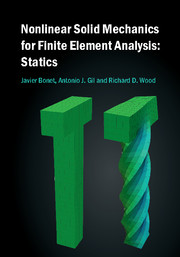Book contents
- Frontmatter
- Dedication
- Epigraph
- Contents
- Preface
- 1 INTRODUCTION
- 2 MATHEMATICAL PRELIMINARIES
- 3 ANALYSIS OF THREE-DIMENSIONAL TRUSS STRUCTURES
- 4 KINEMATICS
- 5 STRESS AND EQUILIBRIUM
- 6 HYPERELASTICITY
- 7 LARGE ELASTO-PLASTIC DEFORMATIONS
- 8 LINEARIZED EQUILIBRIUM EQUATIONS
- 9 DISCRETIZATION AND SOLUTION
- 10 COMPUTER IMPLEMENTATION
- Bibliography
- Index
6 - HYPERELASTICITY
Published online by Cambridge University Press: 05 June 2016
- Frontmatter
- Dedication
- Epigraph
- Contents
- Preface
- 1 INTRODUCTION
- 2 MATHEMATICAL PRELIMINARIES
- 3 ANALYSIS OF THREE-DIMENSIONAL TRUSS STRUCTURES
- 4 KINEMATICS
- 5 STRESS AND EQUILIBRIUM
- 6 HYPERELASTICITY
- 7 LARGE ELASTO-PLASTIC DEFORMATIONS
- 8 LINEARIZED EQUILIBRIUM EQUATIONS
- 9 DISCRETIZATION AND SOLUTION
- 10 COMPUTER IMPLEMENTATION
- Bibliography
- Index
Summary
INTRODUCTION
The equilibrium equations derived in Chapter 5 are written in terms of the stresses inside the body. These stresses result from the deformation of the material, and it is now necessary to express them in terms of some measure of this deformation such as, for instance, the strain. These relationships, known as constitutive equations, obviously depend on the type of material under consideration and may be dependent on or independent of time. For example, the classical small strain linear elasticity equations involving Young's modulus and Poisson's ratio are timeindependent, whereas viscous fluids are clearly entirely dependent on strain rate.
Generally, constitutive equations must satisfy certain physical principles. For example, the equations must obviously be objective, that is, frame-invariant. In this chapter the constitutive equations will be established in the context of a hyperelastic material, whereby stresses are derived from a stored elastic energy function. Although there are a number of alternative material descriptions that could be introduced, hyperelasticity is a particularly convenient constitutive equation, given its simplicity, and it constitutes the basis for more complex material models such as elastoplasticity, viscoplasticity, and viscoelasticity.
HYPERELASTICITY
Materials for which the constitutive behavior is only a function of the current state of deformation are generally known as elastic. Under such conditions, any stress measure at a particle X is a function of the current deformation gradient F associated with that particle. Instead of using any of the alternative strain measures given in Chapter 4, the deformation gradient F, together with its conjugate first Piola–Kirchhoff stress measure P, will be retained in order to define the basic material relationships. Consequently, elasticity can be generally expressed as
where the direct dependency upon X allows for the possible inhomogeneity of the material.
In the special case when the work done by the stresses during a deformation process is dependent only on the initial state at time t0 and the final configuration at time t, the behavior of the material is said to be path-independent and the material is termed hyperelastic.
- Type
- Chapter
- Information
- Nonlinear Solid Mechanics for Finite Element Analysis: Statics , pp. 158 - 187Publisher: Cambridge University PressPrint publication year: 2016



